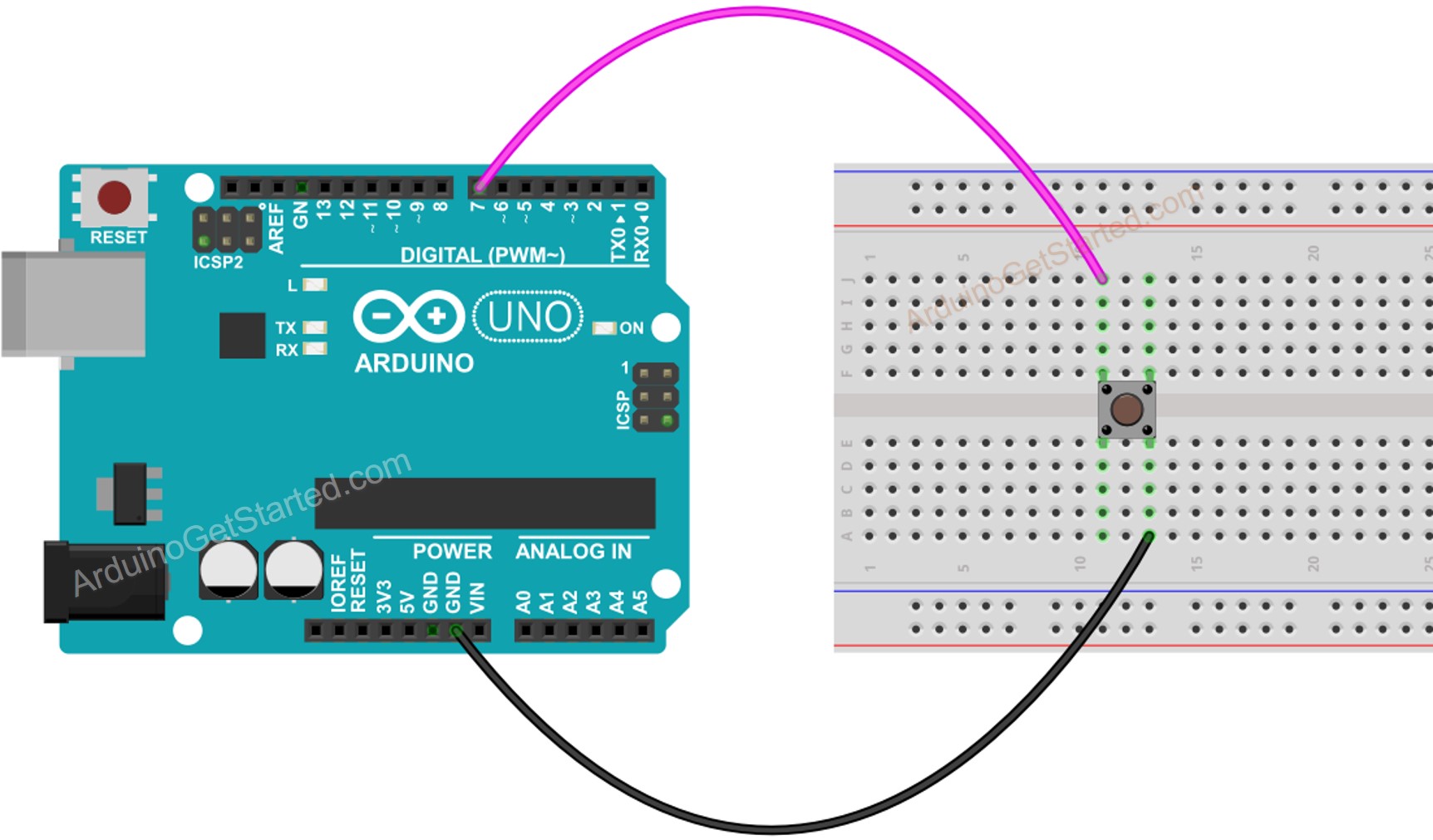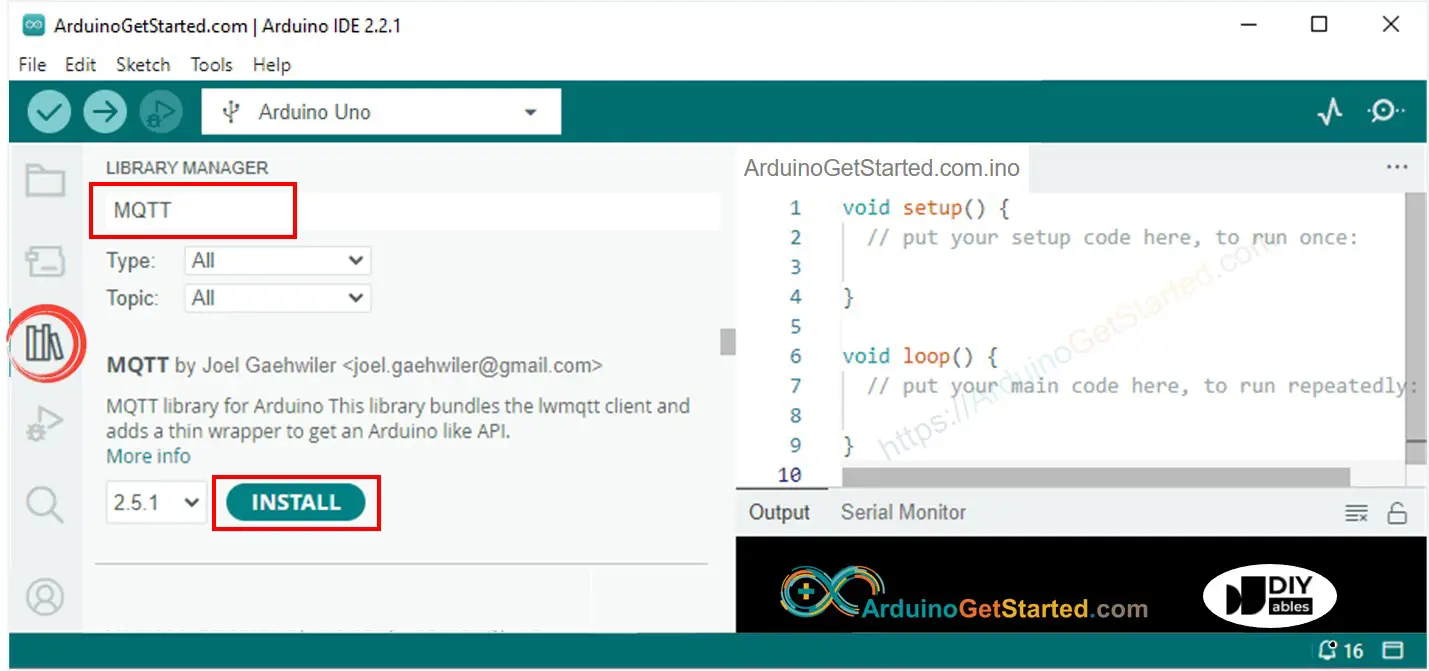Arduino to Arduino MQTT Communication
In this tutorial, we are going to learn:
Or you can buy the following kits:
Disclosure: Some links in this section are Amazon affiliate links. If you make a purchase through these links, we may earn a commission at no extra cost to you.
Additionally, some links direct to products from our own brand,
DIYables .
We have a detailed tutorial on how to use Arduino with MQTT here:
Two Arduino boards can communicate with each other through an MQTT server. If you wish for two Arduinos to communicate directly without using an MQTT server, please refer to the tutorial on Arduino to Arduino TCP Client/Server communication.
When Arduino #1 and Arduino #2 exchange data via an MQTT broker:
Both Arduinos connect to the MQTT broker.
To have Arduino #2 send data to Arduino #1:
Arduino #1 subscribes to a topic, for instance: arduino-1/data.
Arduino #2 can send data to Arduino #1 by publishing the data to the topic that Arduino #1 is subscribed to.
Similarly, to have Arduino #1 send data to Arduino #2:
Arduino #2 subscribes to a topic, for instance: arduino-2/data.
Arduino #1 can send data to Arduino #2 by publishing the data to the topic that Arduino #2 is subscribed to.
By following this method, two Arduinos can exchange data bidirectionally.
Let's realize the following application: A button/switch connected to Arduino #1 controls an LED connected to Arduino #2 via MQTT.
As mentioned above, there are some application protocols we can use. In this example, to make it simple, we will define a protocol by ourself (a self-defined protocol)
Let's define a simple protocol:
Arduino #1 and Arduino #2 connects to MQTT Broker (MQTT server)
Arduino #1:
Arduino #1 publish a MQTT message to a topic when the state of switch is changed.
When the button/switch is switched to on, the MQTT message payload is 1.
When the button/switch is switched to off, the MQTT message payload is 0.
Arduino #2:
Arduino #2 subscribes to the topic
If Arduino #2 receives an MQTT message with payload is 1, it turns on LED
If Arduino #2 receives an MQTT message with payload is 0, it turns off LED

This image is created using Fritzing. Click to enlarge image

This image is created using Fritzing. Click to enlarge image
#include <WiFiS3.h>
#include <MQTTClient.h>
#include <ezButton.h>
const int BUTTON_PIN = 7;
const char WIFI_SSID[] = "YOUR_WIFI_SSID";
const char WIFI_PASSWORD[] = "YOUR_WIFI_PASSWORD";
const char MQTT_BROKER_ADRRESS[] = "test.mosquitto.org";
const int MQTT_PORT = 1883;
const char MQTT_CLIENT_ID[] = "arduino-001";
const char MQTT_USERNAME[] = "";
const char MQTT_PASSWORD[] = "";
const char MQTT_TOPIC[] = "arduino/command";
WiFiClient network;
MQTTClient mqtt = MQTTClient(256);
ezButton button(BUTTON_PIN);
void setup() {
Serial.begin(9600);
button.setDebounceTime(100);
Serial.println("ARDUINO #1: CONNECTED TO A BUTTON/SWITCH, ACTED AS A MQTT PUBLISHER");
int status = WL_IDLE_STATUS;
while (status != WL_CONNECTED) {
Serial.print("Arduino - Attempting to connect to SSID: ");
Serial.println(WIFI_SSID);
status = WiFi.begin(WIFI_SSID, WIFI_PASSWORD);
delay(10000);
}
Serial.print("IP Address: ");
Serial.println(WiFi.localIP());
connectToMQTT();
}
void loop() {
mqtt.loop();
button.loop();
if (button.isPressed()) {
Serial.println("- The button is pressed, send command: 1");
sendToMQTT('1');
}
if (button.isReleased()) {
Serial.println("- The button is released, send command: 0");
sendToMQTT('0');
}
}
void connectToMQTT() {
mqtt.begin(MQTT_BROKER_ADRRESS, MQTT_PORT, network);
Serial.print("Arduino - Connecting to MQTT broker");
while (!mqtt.connect(MQTT_CLIENT_ID, MQTT_USERNAME, MQTT_PASSWORD)) {
Serial.print(".");
delay(100);
}
Serial.println();
if (!mqtt.connected()) {
Serial.println("Arduino - MQTT broker Timeout!");
return;
}
Serial.println("Arduino - MQTT broker Connected!");
}
void sendToMQTT(char command) {
char messageBuffer[1];
messageBuffer[0] = command;
mqtt.publish(MQTT_TOPIC, messageBuffer);
Serial.println("Arduino - sent to MQTT:");
Serial.print("- topic: ");
Serial.println(MQTT_TOPIC);
Serial.print("- payload:");
Serial.println(messageBuffer);
}
#include <WiFiS3.h>
#include <MQTTClient.h>
const int LED_PIN = 9;
const char WIFI_SSID[] = "YOUR_WIFI_SSID";
const char WIFI_PASSWORD[] = "YOUR_WIFI_PASSWORD";
const char MQTT_BROKER_ADRRESS[] = "test.mosquitto.org";
const int MQTT_PORT = 1883;
const char MQTT_CLIENT_ID[] = "arduino-002";
const char MQTT_USERNAME[] = "";
const char MQTT_PASSWORD[] = "";
const char MQTT_TOPIC[] = "arduino/command";
WiFiClient network;
MQTTClient mqtt = MQTTClient(256);
void setup() {
Serial.begin(9600);
pinMode(LED_PIN, OUTPUT);
Serial.println("ARDUINO #2: CONNECTED TO A LED, ACTED AS A MQTT SUBSCRIBER");
int status = WL_IDLE_STATUS;
while (status != WL_CONNECTED) {
Serial.print("Arduino - Attempting to connect to SSID: ");
Serial.println(WIFI_SSID);
status = WiFi.begin(WIFI_SSID, WIFI_PASSWORD);
delay(10000);
}
Serial.print("IP Address: ");
Serial.println(WiFi.localIP());
connectToMQTT();
}
void loop() {
mqtt.loop();
}
void connectToMQTT() {
mqtt.begin(MQTT_BROKER_ADRRESS, MQTT_PORT, network);
mqtt.onMessage(messageReceived);
Serial.print("Arduino - Connecting to MQTT broker");
while (!mqtt.connect(MQTT_CLIENT_ID, MQTT_USERNAME, MQTT_PASSWORD)) {
Serial.print(".");
delay(100);
}
Serial.println();
if (!mqtt.connected()) {
Serial.println("Arduino - MQTT broker Timeout!");
return;
}
if (mqtt.subscribe(MQTT_TOPIC))
Serial.print("Arduino - Subscribed to the topic: ");
else
Serial.print("Arduino - Failed to subscribe to the topic: ");
Serial.println(MQTT_TOPIC);
Serial.println("Arduino - MQTT broker Connected!");
}
void messageReceived(String &topic, String &payload) {
Serial.println("Arduino - received from MQTT:");
Serial.println("- topic: " + topic);
Serial.print("- payload: ");
Serial.println(payload);
char command = payload[0];
if (command == '1') {
Serial.print("- Received command: ");
Serial.print(command);
Serial.println(" => Turned LED on");
digitalWrite(LED_PIN, HIGH);
} else if (command == '0') {
Serial.print("- Received command: ");
Serial.print(command);
Serial.println(" => Turned LED off");
digitalWrite(LED_PIN, LOW);
} else {
Serial.print("- Received an unsupported command: ");
Serial.println(command);
}
}
Wire a button/switch to Arduino #1
Wire an LED to Arduino #2
Open Arduino IDE (called Arduino IDE #1)
Open another Arduino IDE window (called Arduino IDE #2) by clicking on Arduino IDE icon on your PC (important!())
Open the Library Manager by clicking on the Library Manager icon on the left navigation bar of Arduino IDE
Type MQTT on the search box, then look for the MQTT library by Joel Gaehwiler.
Click Install button to install MQTT library.
Type ezButton on the search box, then find the button library by ArduinoGetStarted
Click Install button to install ezButton library.

Connect Arduino #1 to PC via USB cable and select COM port of Arduino #1 on Arduino IDE #1
Connect Arduino #2 to PC via USB cable and select COM port of Arduino #2 on Arduino IDE #2
Copy Arduino #1 code, paste to Arduino IDE #1 and save it (named Arduino-1)
Copy Arduino #2 code, paste to Arduino IDE #2 and save it (named Arduino-2)
Replace the WiFi information (SSID and password) in both codes with your own.
Replace the MQTT broker address in both codes (domain name or IP address).
Upload Arduino #1 code to Arduino #1
Upload Arduino #2 code to Arduino #2
Open Serial Monitor on Arduino IDE #1
Open Serial Monitor on Arduino IDE #2
Press and hold the button on Arduino #1 → see LED's state on Arduino #2 (ON)
Release button on Arduino #1 → see LED's state on Arduino #2 (OFF)
Press, hold, and release the button several times.
See output on both Serial Monitors
Arduino #1: CONNECTED TO A BUTTON/SWITCH, ACTED AS A MQTT PUBLISHER
Arduino - Attempting to connect to SSID: YOUR_WIFI_SSID
IP Address: 192.168.0.2
Arduino - Connecting to MQTT broker
Arduino - MQTT broker Connected!
- The button is pressed, send command: 1
Arduino - sent to MQTT:
- topic: arduino/command
- payload:1
- The button is released, send command: 0
Arduino - sent to MQTT:
- topic: arduino/command
- payload:0
Arduino #2: CONNECTED TO A LED, ACTED AS A MQTT SUBSCRIBER
Arduino - Attempting to connect to SSID: YOUR_WIFI_SSID
IP Address: 192.168.0.2
Arduino - Connecting to MQTT broker
Arduino - Subscribed to the topic: arduino/command
Arduino - MQTT broker Connected!
Arduino - received from MQTT:
- topic: arduino/command
- payload: 1
- Received command: 1 => Turned LED on
Arduino - received from MQTT:
- topic: arduino/command
- payload: 0
- Received command: 0 => Turned LED off
※ OUR MESSAGES
You can share the link of this tutorial anywhere. Howerver, please do not copy the content to share on other websites. We took a lot of time and effort to create the content of this tutorial, please respect our work!






